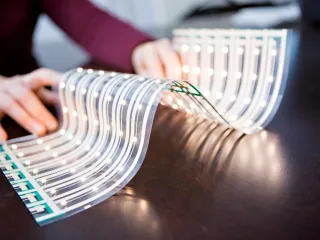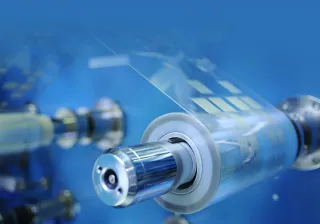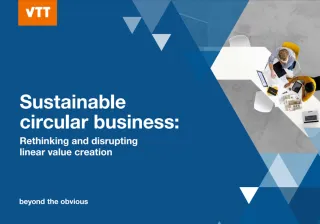The startup company Flexbright commercialises VTT-developed embedded electronics technology in lighting and signage applications, with bus windscreen displays piloted in 2018. Coupled with IoT capabilities, the led foil can include built-in diagnostics and sensors for ambient measurements.
Challenge
- New development for miniature, low-power LED technology
- Demand for lightweight, low-power lighting in many industries
- How to mass-produce at a commercially viable cost?
Solution
- VTT’s roll-to-roll production technology
- Bendable LED foil that lends itself to a multitude of uses
- Lighting, signage, advertising applications
Benefit
- Huge range of possible applications
- Roll-to-roll technology allows embedding sensors and other smart tech
- Led to development of stretchable electronics
- Flexbright set to multiply revenue
Fabric-thin light fixtures
Founded in 2013, Flexbright has developed one of the most innovative products in lighting, LEDFOIL, in collaboration with VTT Technical Research Centre of Finland. The exciting new technology is based on roll-to-roll (R2R) mass production capacity, IoT capabilities, low energy consumption, large area and, most importantly of all, an ultra-thin flexible construction that is less than one millimetre thick. The applications for this brand-new lighting system are almost infinite, from industrial to commercial to domestic.
New technologies come together
When worldwide lighting trends were shifting towards LED lighting in the first decade of the millennium, VTT was already examining the possibilities of LED technology. On the one hand, there were the high-power bulbs used, for example, in street lights, on the other, miniature OLEDs (Organic Light-Emitting Diode) that required less power, generated less heat, and could be printed on flexible substrates.
By 2007, the price of semiconductor LEDs had decreased, and unpackaged elements started to appear on the market. Development started on bonding LED elements to a flexible substrate. In 2012, PrintoCent, VTT’s pilot facility in Oulu, Finland, completed its first R2R bonding machine, producing the first demonstrations of thin-film LED stripes where the components were all but invisible to the eye.
At this point, Pekka Makkonen, a serial entrepreneur and active in the illuminated sign business, became interested in the new technology. The first applications involved white LED strips for lighting and illuminated signage. Having founded the startup Flexbright to commercialise the new technology, the idea changed on the fly at a trade fair in Dubai where potential customers were more interested in pixel controllable, coloured LED strips. The initial production runs took place at VTT’s PrintoCent facility, specialising in R2R printing. When these proved successful, and leveraging VTT’s participation, Flexbright set up its first own production line in the beginning of 2018.

Commercially viable mass production
Competing technical solutions typically utilise etched copper laminates on polyimide (PI) and reflow soldering process. The solution used by Flexbright is based on low-cost polymer materials, such as PET, PEN, PC onto which LED devices are embedded in an adhesive bonding process. In addition to the typical packaged surface mount device (SMD) LEDs, Flexbright can use also chip scale packaged (CSP) LEDs or bare LED chips in lighting elements. This enables the manufacture of thinner, lighter, more flexible and efficient lighting foil elements than existing competing solutions. The layered construction allows the integration of different kinds of functional foil layers, while the flexible substrate and hybrid technology make it possible to produce highly customised end products.
LEDFOIL strips feature RGB type LEDs with the elements about one to a few centimetres apart. For lighting, this is more than enough, and as signs are usually viewed from a distance, it is sufficient to provide clearly readable lettering. LEDFOIL’s efficacy surpasses that of traditional bulbs almost by a factor of ten: 102 lm/W, when a 100-watt traditional bulb produces less than 14 lm/W.
A new concept of lighting
Flexbright’s LEDFOIL enables customers to use light in places where it hasn’t been used before – general lighting, large area LED matrix screens, infrastructure lighting, automotive solutions, interior coating, design and decoration solutions, home textiles, aerospace, advert signs, exhibitions, office and industrial lighting solutions, to name some examples.
One interesting application is the People’s light, a new textile product developed by the Finnish textile company Finlayson. The light includes a LED-embedded light film that lasts up to 100,000 hours. The lamp is light and can be folded flat, making it an ideal product for web stores and retailers. The plug-in product is lightweight and doesn’t heat up – you can even hold it in your lap.
This product development case with Finlayson was a brilliant example how to bring a new product from the first idea to a commercially ready product within a very short time. The People’s light was launched at the Maison&Objet fair Paris in January 2016 after an 80-day project, including a one-week Christmas holiday,
LEDFOIL has also been used to create light sculptures, and it can provide even lighting in any space, even conforming to architecturally complicated structures.

In business-to-business use, the strips lend themselves to a variety of uses, from lighting to dynamic displays at the front of buses or trams. Flexbright is collaborating with NSG Pilkington for professional applications across Europe. Pilkington’s distribution channels provide an important foothold in large markets. Dynamic windshield displays made of LEDFOIL will start to be tested on buses and trams during 2018.
Automotive, shipbuilding and aerospace manufacturers are interested in the light weight, flexibility and small volume of the product, combined with low power consumption and high efficacy. Examples include vehicle tail lights, cabin lighting or emergency exit signage.
The LED stripe can also include other embedded electronics, making it IoT-enabled. Sensors may collect traffic data, measure road conditions or adjust the brightness of the sign according to ambient light. Self-diagnostics can be built in.
New applications and markets
New technologies, such as LEDFOIL, are an important boost for VTT’s research while helping enterprises adopt new technologies for commercial benefit and growth. R2R manufacturing is also a way to keep manufacturing in Finland as big innovations can be produced with printing technology that does not require much manual work and thereby eliminates the need for offshoring.
The collaboration between researchers and enterprises expands the reach of wide-area electronics to new industries, such as wearables. Flexbright and VTT are co-developing stretchable electronics even for other applications than lighting. The roll-to-roll process allows embedding any components, such as sensors, to the substrate, which presents exciting new opportunities for diagnostics, healthcare and medical applications.
Close cooperation with VTT has been excellent support for Flexbright. There have been some customer needs for which Flexbright could not have provided a solution alone. But together with VTT, we have found an optimal solution for our customers.
For companies such as Flexbright, melding top-notch research and commercialisation open up possibilities to create totally new value chains and business opportunities. In the case of Flexbright, the company is looking to grow its revenue to €30 million in the next five years.




